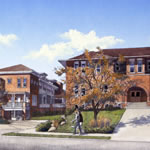The USGBC’s relatively new LEED for Neighborhood Development (LEED-ND) rating system attempts to integrate principles of new urbanism and green building. Which is why Washington Village in Boulder, Colorado, makes a perfect pilot project for the rating’s beta test. The residential project, by Wonderland Hill Development, is not just any housing subdivision—it’s a cohousing community.
LEED-ND certification considers not only the construction of buildings in a neighborhood but also the overall long-term performance of the community.
Jim Leach, president of Wonderland, says his vision for Washington Village was the same. “We felt [this] was the ideal site to design a cohousing community,” Leach says. “We looked at green building in the broadest sense, considering environmental, economic, and social sustainability. Washington Village will bring people and resources together in a way that creates a more carbon-neutral lifestyle.”
Located on just more than three acres, Washington Village began construction in spring 2011 and will be completed in early 2015. The development will contain 33 energy-efficient residential units—10 of which will be guaranteed to be affordable through a city program. The cohousing project contains five housing types: flats, duplexes, townhouses, a historic building with condo flats, and single-family homes. Units range in size from 600 square feet to 4,000 square feet and are priced at $80,000 to $1.5 million.
22
Cohousing communities Wonderland Hill Development has been a part of in the western United States. In total, the US has approximately 120 such communities.
Although the development brings together a diverse economic group, Washington Village deliberately links neighbors through the sharing of common facilities such as a library, a wood shop, and spaces for bike repair, artisanship, guests, gathering, and cooking.
Leach took a comprehensive environmental approach in considering what was appropriate for each structure on-site. Wonderland researched technology advancements from around the world and modeled its single-family homes after what is being done in Europe. “We are doing some of the first work with the Bosch technology,” Leach says. The Bosch system will draw approximately 4,000 kilowatt-hours a year for ventilation, heating, cooling, and domestic hot water. The developer assumes single-family homeowners will use an additional 5,000 kilowatt-hours, but with the installation of a 7.5-kilowatt photovoltaic system, the annual demand will be covered and the home will net zero energy.
In addition, a Bosch geothermal system with earth tubes will allow residents to get all their heating and cooling from the ground. “The building is very tight,” Leach says. “The energy usage will be much less volatile.”
Leach is one of the largest developers of cohousing in the United States. “Cohousing really ramped up in recent years,” he says. “I think the recession, which killed housing of all kinds, prompted people to start thinking about the way they want to live and the places they wanted to live.”
Washington Village also is considered a transit-oriented development. It is a walkable site, which is attractive to the general population but especially to certain groups of people, including baby boomers and young families. “As people learn about the product they simply wonder why this isn’t being completed all over the nation as a viable housing type,” says Peter Spaulding, marketing director for Wonderland. “It is all about education.”

